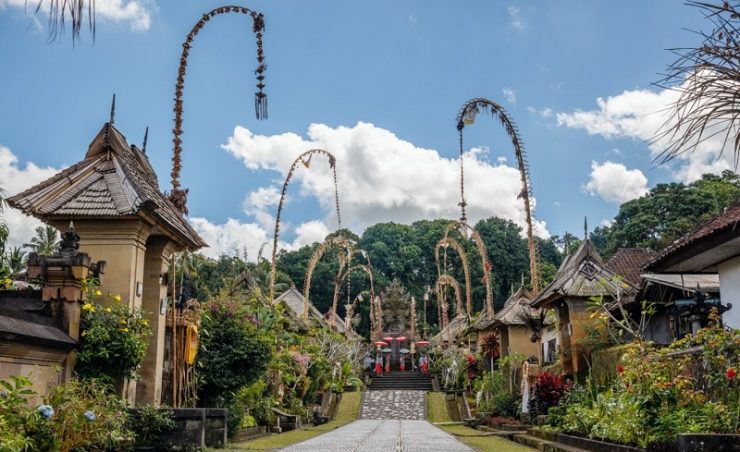MUNGGUING tetampen pengertian sang megama bali Hindu sepedaging penjore, Praya katur ring Hyang Betara ring Gunung Agung, anut Lontar Usana Bali, Gunung Agung linggih Hyang Bhatara Putra Jaya, Putran Betara Pasupati saking Gunung Semeru ring Jawi.
This is a fragment of the role of the penjor in the Usana Bali lontar, which is quoted in the Galungan & Kuningan Penjor Philosophy Value, I Made Nada Atmaja, et al, Paramita Publisher Surabaya (2008). The essence of the fragment–according to the understanding of Balinese Hindus-is the penjor as an offering to Hyang Betara Gunung Agung, the abode of the Gods.
Balinese Penjor is a complete bamboo stick decorated with specially shaped young coconut leaves. At first glance, the shape resembles a pennant. Usually, the penjor is made as high as 10 meters, which describes the highest mountain.
Balinese Hindus believe that Mount Agung is the residence of Hyang Bathara Putra Jaya and his Gods and ancestors. So, the mountain is the palace of God with various manifestations. And the penjor is a symbol of gratitude and gratitude for the produce of the earth that He has bestowed. And, Mount Agung as the giver of that prosperity.
Recorded in the Jayakasunu lontar, the penjor symbolizes Mount Agung. Furthermore, in Basuki Stawa’s ejection it is stated that the mountain (giri) is a king dragon, which is none other than Naga Basuki.
In mythology, the base of Mount Agung is known as the Linggih Sang Hyang Naga Basuki. From Basuki’s words, the name Besakih emerged. Naga Basuki, in Basuki Stawa, is depicted that his tail is on the top of the mountain and his head is in the sea, which is a symbol that the mountain is a water storage reservoir which later becomes a river. Finally, it empties into the sea.
So, the mythology of the penjor which is decorated in such a way for religious ceremonies or Balinese Hindu customs, is a symbol of the dragon. Sanggah which is placed on the bamboo penjor wearing a coconut frond is a symbol of the neck and head of Naga Taksaka (there is a coconut that is hung above the sanggah penjor, a place to put offerings).
Then, the gembrong made of coconut leaves is decorated in a circle near the coconut, depicting the hair of a dragon. Sampian penjor with its shaft (which hangs from the top end of the bamboo, which is curved is the tail of Naga Basuki (symbol of the mountain).
The decorations that are attached along the bamboo from the bottom to the top of the penjor, which consist of hanging rice, cassava, corn, cloth, and so on, are a symbol of Naga Ananta Bhoga’s feathers, as a place for growing clothing and food.
In International Events
Balinese Penjor is a form of gratitude given to Ida Sang Hyang Widhi Wasa for sending Sang Hyang Tri Murti to help humanity from hunger and disaster.
In the context of gratitude and gratitude, the Provincial Government of Bali installed as many as 2,500 penjors along the road from I Gusti Ngurah Rai Airport to the meeting location and hotel that will be occupied by high-ranking G20 member countries, on 15-16 November 2022.
The design of thousands of penjors to welcome the G20 Summit delegates given to traditional villages is the most special. As is often contested in the Kerobokan area. The regional government has budgeted for the manufacture and installation of the thousands of penjors of IDR 3.5 billion.
Later, the penjors will be divided into two types, namely the intermediate or intermediate types that will be installed on the highway. And the main types installed in the main G20 venues, namely The Apurva Kempinski Hotel (meeting location) and Tahura Mangrove Area (banquet location).
The presence of Penjor at an international-class event, acknowledged by the Chairperson of Paruman Walaka PHDI Bali, Professor Dr I Gusti Ngurah Sudiana, gave a sense of pride.
“The penjor symbol, which actually means an offering and thanksgiving, can serve as a reminder to the participants and delegates of the G20 Summit,” said Sudiana, Wednesday (11/2).
In Bali, Sudiana explained, there are two types of penjor. Namely, the penjor that is installed is related to traditional ceremonies, such as during the Galungan and Kuningan holidays, as well as the pepenjoran penjor. Penjor pepenjoran it can be installed at any time. It doesn’t have to be related to traditional ceremonies or holidays. It was the penjor pepenjoran that was prepared to welcome the delegates of the G20 summit.
On the penjor pepenjoran or decorative penjor, usually there is no penjor stand and penjor sampian. So, the penjor purely functions as a decoration intended to beautify the event.
“Personally, I also hope that the G20 Summit will also benefit Indonesia, especially Bali, as the location for the highlight of the event. Hopefully it can have a positive impact on all fields for all of us,” he said. [sources/photo special]
















